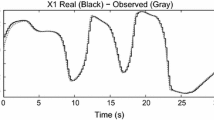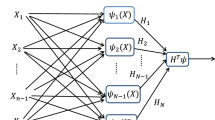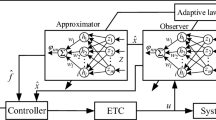Abstract
This paper treats the event-triggered identification of a class of discrete-time nonlinear dynamical systems. Feedforward neural networks are trained online to behave like the given plant. With event triggering, the neural network parameters are not updated with every available data point. Instead, training takes place as and when required. We show that event-triggered identification requires only a small percentage of data points, resulting in considerably less computational requirement. In addition, we demonstrate that introducing multiple identification models in this scenario requires fewer data points with minimal degradation in the identification performance. We further show that this is better possible with the online sequential learning algorithm for networks with one or two hidden layers than the traditional back propagation algorithm.






Similar content being viewed by others
References
Åarzén, K. E. (1999). A simple event-based PID controller. In Proceedings of 14th IFAC World Congress, Beijing, China, pp. 8687–8692. IFAC Proceedings Volume 32, Issue 2.
Åström, K. J., & Bernhardsson, B. M. (2002). Comparison of Riemann and Lebesgue sampling for first-order stochastic systems. In Proceedings of 41st Conference on Decision and Control (CDC), Las Vegas, NV, USA, pp. 2011–2016.
Billings, S. A. (2013). Nonlinear system identification: NARMAX methods in the time, frequency, and Spatio-Temporal domains. London, UK: Wiley.
Bryson, A. E. (1961). A gradient method for optimizing multi-stage allocation processes. In Proceedings of the Harvard University Symposium on Digital Computers and Their Applications, Cambridge, MA, USA.
Chen, S., & Billings, S. A. (1989). Representations of nonlinear systems: The NARMAX model. International Journal of Control, 49(3), 1013–1032.
Chen, S., & Billings, S. A. (1992). Neural networks for nonlinear dynamic system modelling and identification. International Journal of Control, 56(2), 319–346.
Chen, S., Billings, S. A., Cowan, C. F. N., & Grant, P. M. (1990). Practical identification of NARMAX models using radial basis functions. International Journal of Control, 52(6), 1327–1350.
Cybenko, G. (1989). Approximation by superpositions of sigmoidal function. Mathematics of Control, Signal, and Systems, 2, 303–314.
Dreyfus, S. E. (1990). Artificial neural networks, back propagation, and the Kelly–Bryson gradient procedure. Journal of Guidance, Control, and Dynamics, 13(5), 926–928.
Freedman, D., Pisani, R., & Purves, R. (2007). Statistics (4th ed.). New York, NY, USA: W. W. Norton and Company.
Funahashi, K. (1989). On the approximate realization of continuous mappings by neural networks. Neural Networks, 2, 183–192.
George, K., & Mutalik, P. (2019). A multiple model approach to time-series prediction using an online sequential learning algorithm. IEEE Transactions on Systems, Man, and Cybernetics: Systems, 49(5), 976–990.
George, K., & Narendra, K. S. (2019). Multiple models: A survey. In Proceedings of the 19th Yale Workshop on Adaptive and Learning Systems, Yale University, New Haven, Connecticut, USA. Yale University.
George, K., Verhaegen, M., & Scherpen, J. M. A. (1999). A systematic and numerically efficient procedure for stable dynamic model inversion of LTI systems. In Procedings of the 38th IEEE Conference on Decision and Control (CDC), Phoenix, Arizona, U.S.A.
Girard, A. (2015). Dynamic triggering mechanisms for event-triggered control. IEEE Transactions on Automatic Control, 60(7), 1992–1997.
Hornik, K., Stinchcombe, M., & White, H. (1989). Multilayer feedforward networks are universal approximators. Neural Networks, 2, 359–366.
Hunt, K. J., & Sbarbaro, D. (1991). Neural networks for nonlinear internal model control. In IEE Proceedings D (Control Theory and Applications), 138(5), pp. 431–438.
Hunt, K. J., Sbarbaro, D., Zbikowski, R., & Gawthrop, P. J. (1992). Neural networks for control systems —a survey. Automatica, 28(6), 1083–1112.
Kelly, H. J. (1960). Gradient theory of optimal flight paths. ARS Journal, 30(10), 947–954.
Leontartis, I. J., & Billings, S. A. (1985). Input-output parametric models for non-linear systems – Part 1: Deterministic non-linear systems Part 2: Stochastic non-linear systems. International Journal of Control, 41(2), 303–328.
Ljung, L. (1999). System identification — theory for the user (2nd ed.). Englewood Cliffs, NJ, USA: Prentice Hall.
Lu, J., Wei, Q., Liu, Y., Zhou, T., & Wang, F. Y. (2022). Event-triggered optimal parallel tracking control for discrete-time nonlinear systems. IEEE Transactions on Systems, Man, and Cybernetics: Systems, 52(6), 3772–3784.
Massey, F. J., Jr. (1951). The Kolmogorov-Smirnov test for goodness of fit. Journal of the American Statistical Association, 46(253), 68–78.
Merlin, G. B., Moreira, L. G., & Gomes da Silva, J. M., Jr. (2021). Periodic event-triggered control for linear systems in the presence of cone-bounded nonlinear inputs: A discrete-time approach. Journal of Control, Automation and Electrical Systems, 32, 42–56.
Mizutani, E., Dreyfus, S. E., & Nishio, K. (2000). On derivation of MLP backpropagation from the Kelley-Bryson optimal-control gradient formula and its application. In Proceedings of the International Joint Conference on Neural Networks, Como, Italy.
Narendra, K. S., & Annaswamy, A. M. (1987). Persistent excitation in adaptive systems. International Journal of Control, 45(1), 127–160.
Narendra, K. S., & Annaswamy, A. M. (1989). Stable Adaptive Systems. Englewood Cliffs, New Jersey, USA: Prentice-Hall.
Narendra, K. S., & Balakrishnan, J. (1994). Improving transient response of adaptive control systems using multiple models and switching. IEEE Transactions on Automatic Control, 39(9), 1861–1866.
Narendra, K. S., & Parthasarathy, K. (1990). Identification and control of dynamical systems using neural networks. IEEE Transactions on Neural Networks, 1(1), 4–27.
Patel, R., Mandradia, D., & George, K. (2022). A novel training algorithm for neuro-control of discrete-time nonlinear systems. In Proceedings of the 8th IEEE International Conference on Electronics, Computing and Communication Technologies (CONECCT), Bangalore, India.
Rumelhart, D. E., Hinton, G. E., & Williams, R. J. (1986). Learning representations by back-propagating errors. Nature, 323(9), 533–536.
Sriram, T. B., Kashi, M. S., Ugarakhod, R., & George, K. (2019). Meta-cognitive neural networks for adaptive identification and control. In Proceedings of the 2019 IEEE TENCON, Kochi, India, pp. 2257–2261.
Van Overschee, P., & De Moor, B. (1996). Subspace identification for linear systems: Theory —implementation – Applications. Norwell, MA, USA: Kluwer Academic Publishers.
Verhaegen, M., & Verdult, V. (2007). Filtering and system identification: A least squares approach. Cambridge, U.K.: Cambridge University Press.
Viana, É. S., Gomes da Silva, J. M., Jr., & Moreira, L. G. (2022). Disturbance rejection for uncertain discrete-time linear systems through event-triggered control. Journal of Control, Automation and Electrical Systems, 33, 103–114.
Werbos, P. J. (1974). Beyond Regression: New Tools for Prediction and Analysis in the Behavioral Sciences. Ph. D. thesis, Harvard University, Cambridge, MA, USA.
Wu, L. B., Park, J. J., Xie, X. P., & Li, Y. F. (2022). Adaptive asymptotic tracking control of uncertain nonlinear systems based on Taylor decoupling and event-trigger. IEEE Transactions on Systems, Man and Cybernetics: Systems, 52(4), 2053–2060.
Yan, Y., Wu, L., He, X., & Chen, M. (2022). Adaptive fault-tolerant tracking control of uncertain nonlinear systems with event-triggered inputs and full state constraints. Journal of Control, Automation and Electrical Systems. https://doi.org/10.1007/s40313-022-00929-8
Acknowledgements
The authors thank the reviewers for their support through criticisms and comments which helped in improving the quality of the paper.
Author information
Authors and Affiliations
Corresponding author
Ethics declarations
Conflict of interest
The authors declare that they have no conflict of interest.
Additional information
Publisher's Note
Springer Nature remains neutral with regard to jurisdictional claims in published maps and institutional affiliations.
Rights and permissions
Springer Nature or its licensor (e.g. a society or other partner) holds exclusive rights to this article under a publishing agreement with the author(s) or other rightsholder(s); author self-archiving of the accepted manuscript version of this article is solely governed by the terms of such publishing agreement and applicable law.
About this article
Cite this article
Ugarakhod, R., Tripathi, S. & George, K. Event-Triggered Multiple-Model Identifier for a Class of Nonlinear Systems. J Control Autom Electr Syst 34, 971–984 (2023). https://doi.org/10.1007/s40313-023-01015-3
Received:
Revised:
Accepted:
Published:
Issue Date:
DOI: https://doi.org/10.1007/s40313-023-01015-3




